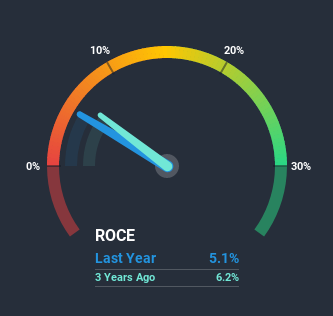Should We Be Excited About The Trends Of Returns At Severn Trent (LON:SVT)?
Did you know there are some financial metrics that can provide clues of a potential multi-bagger? Ideally, a business will show two trends; firstly a growing return on capital employed (ROCE) and secondly, an increasing amount of capital employed. Basically this means that a company has profitable initiatives that it can continue to reinvest in, which is a trait of a compounding machine. Having said that, from a first glance at Severn Trent (LON:SVT) we aren't jumping out of our chairs at how returns are trending, but let's have a deeper look.
Return On Capital Employed (ROCE): What is it?
For those that aren't sure what ROCE is, it measures the amount of pre-tax profits a company can generate from the capital employed in its business. Analysts use this formula to calculate it for Severn Trent:
Return on Capital Employed = Earnings Before Interest and Tax (EBIT) ÷ (Total Assets - Current Liabilities)
0.051 = UK£499m ÷ (UK£11b - UK£1.1b) (Based on the trailing twelve months to September 2020).
Therefore, Severn Trent has an ROCE of 5.1%. Even though it's in line with the industry average of 5.2%, it's still a low return by itself.
See our latest analysis for Severn Trent
In the above chart we have measured Severn Trent's prior ROCE against its prior performance, but the future is arguably more important. If you'd like to see what analysts are forecasting going forward, you should check out our free report for Severn Trent.
What The Trend Of ROCE Can Tell Us
In terms of Severn Trent's historical ROCE movements, the trend isn't fantastic. Around five years ago the returns on capital were 7.3%, but since then they've fallen to 5.1%. However it looks like Severn Trent might be reinvesting for long term growth because while capital employed has increased, the company's sales haven't changed much in the last 12 months. It may take some time before the company starts to see any change in earnings from these investments.
The Key Takeaway
To conclude, we've found that Severn Trent is reinvesting in the business, but returns have been falling. And investors may be recognizing these trends since the stock has only returned a total of 32% to shareholders over the last five years. As a result, if you're hunting for a multi-bagger, we think you'd have more luck elsewhere.
If you want to know some of the risks facing Severn Trent we've found 3 warning signs (1 can't be ignored!) that you should be aware of before investing here.
While Severn Trent isn't earning the highest return, check out this free list of companies that are earning high returns on equity with solid balance sheets.
This article by Simply Wall St is general in nature. It does not constitute a recommendation to buy or sell any stock, and does not take account of your objectives, or your financial situation. We aim to bring you long-term focused analysis driven by fundamental data. Note that our analysis may not factor in the latest price-sensitive company announcements or qualitative material. Simply Wall St has no position in any stocks mentioned.
Have feedback on this article? Concerned about the content? Get in touch with us directly. Alternatively, email editorial-team (at) simplywallst.com.

